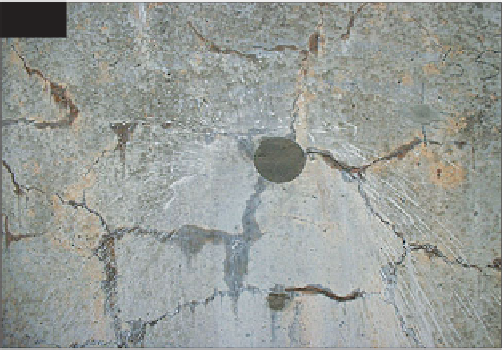Geoscience Reference
In-Depth Information
Almost all AAR investigations involve microscopical
examination, which is the definitive method for
identifying deleterious reactions. Guidance for
investigating structures suspected of suffering from AAR
can be found in Palmer (1992) and the structural effects
are discussed in an Institution of Structural Engineers
publication (1992). Guidance for avoiding AAR in new
concrete construction can be found in BRE Digest 330
(Building Research Establishment, 2004) and Concrete
Society Technical Report No.30 (1999).
ASR, the most common form of AAR, is a two-stage
process. Initially alkali hydroxides react with susceptible
siliceous aggregate constituents in the presence of
moisture to form alkali-silica gel as follows (the chemical
equation can also be written with potassium in place of
sodium):
SiO
2
The relative ASR reactivity for different types of
aggregate constituent is shown in
Table 15
and
procedures for determining the potential alkali-silica
reactivity of concrete aggregate combinations is
discussed on pp. 69-73. Figure
219
shows the
appearance in thin section of ASR in concrete made with
crushed greywacke coarse aggregate, which is classified
as being of 'high' reactivity in accordance with BRE
Digest 330 (Building Research Establishment, 2004).
Figure
220
shows ASR in concrete with flint (chert)
coarse aggregate that is classified as being of 'normal'
reactivity. In both examples alkali-silica gel is present,
being characteristically amorphous and colourless in
plane-polarized light (but may sometimes be yellow or
brown). In cross-polarized light typical amorphous gel is
isotropic. Some areas of gel may convert to a crystalline
form that is birefringent with first-order white
interference colours. Gel near surfaces may carbonate to
give higher-order interference colours more typical of
carbonate minerals. Several staining methods to aid the
identification of alkali-silica gel are described in
Appendix B. These are most useful for highlighting
deposits of gel in field situations or on hand specimens
as gel is usually readily identifiable in thin section.
Cement is the principal source of alkalis that may
become involved in ASR. The alkali content of cement
or concrete is determined by chemical analysis and is
expressed as the Na
2
O equivalent (Na
2
O + 0.658K
2
O).
Generally ASR does not occur unless the alkali content
(as Na
2
Oeq) of the concrete is >3.0 kg/m
3
. Another
possible internal source of alkalis is salt-contaminated
aggregates (e.g. marine dredged). Also, in rare instances,
aggregates that include certain alkali-containing
+
2NaOH
+
H
2
O
→
Na
2
SiO
3
.2H
2
O
Silica
Alkali
Water
Alkali-silica gel
The gel can later absorb further moisture, swelling in the
process and imposing expansive forces on the
surrounding concrete matrix. These expanding reaction
sites generate radiating microcracks and the gel migrates
into the cracks. As ASR progresses, the reaction sites
become linked by a network of widening cracks that may
appear on the outer concrete surface as map cracking
(
218
). Crack patterns and reaction sites can be
successsfully investigated using a combination of
polished slice and thin section examinations. Several
schemes for quantifying petrographic AAR evidence have
been proposed, including one by Sims
et al
. (1992). A
classification for cracking associated with AAR as
observed in thin section is provided in
Table 25
.
218
218
View of a reinforced concrete wall exhibiting map
cracking as a result of ASR. The scale is illustrated by an
infilled core sample hole that is 100 mm in diameter.




